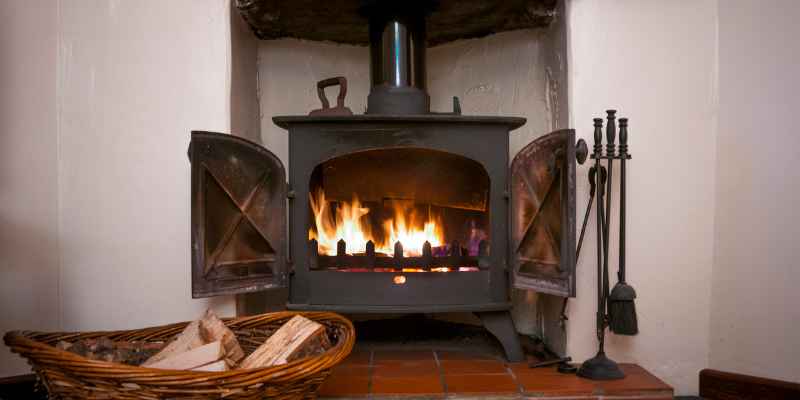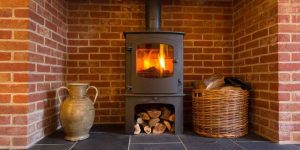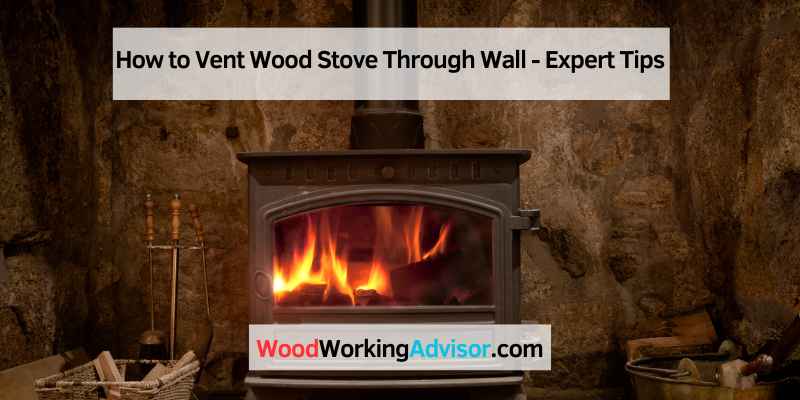To vent a wood stove through a wall, you will need a wall thimble, supervent chimney, and a chimney kit with a pipe, clean out tee, and mounting bracket. Use a reciprocating saw to cut a hole on the wall where you want to install the flue, ensuring that the opening is level.
Install the wall thimble, flue pipe, and other components as per the manufacturer’s instructions, making sure everything is properly sealed to avoid any leaks. It is also crucial to adhere to local building codes and regulations when installing a wood stove chimney through a wall.
By following these steps, you can safely and effectively vent a wood stove through a wall and enjoy a warm and cozy home during the winter season.
Understanding The Wood Stove Venting
Venting your wood stove through a wall can be an excellent option for installations where a chimney is not feasible. Installing a wall thimble and ceiling support box is necessary for proper venting. Additionally, building codes and manufacturer guidelines must be followed to ensure safe and efficient operation.
Wood stove venting is important to ensure safe and efficient operation. When it comes to venting a wood stove through a wall, there are several options available. Each option has its own benefits and drawbacks, depending on your specific situation. It’s essential to understand the types of wood stove venting and the importance of wood stove venting before installing a wood stove.
Types of Wood Stove Venting
There are two main types of wood stove venting: Class A and Direct Vent.
Class A chimneys are made of a stainless steel interior and a stainless steel exterior, with either insulation or an air channel in between the outer and inner wall. You will use this when venting through a wall or through the ceiling all the way to the roof or above the roof line.
Direct Vent is when you vent the stove through a sidewall. This is done by cutting a hole in the wall and installing the flue through the wall. Most direct vent pipes are made of stainless steel, and some are designed to be installed in a wall.
Importance of Wood Stove Venting
Proper wood stove venting is essential to avoid creosote buildup, which can cause a chimney fire. A chimney fire occurs when creosote ignites, causing flames to spread rapidly. Proper wood stove venting also ensures maximum efficiency, which means the stove will burn less wood and produce more heat.
It’s important to note that not following wood stove venting guidelines can also lead to carbon monoxide poisoning. Carbon monoxide is a colorless, odorless gas that can be deadly when inhaled. Ensure your wood stove is vented correctly to prevent carbon monoxide poisoning.
In conclusion, understanding the types of wood stove venting and the importance of wood stove venting is crucial before installing a wood stove. Whether you choose Class A or Direct Vent, ensure your wood stove is vented correctly to operate safely and efficiently.
Preparations Before Venting Through The Wall
Before venting a wood stove through the wall, it is crucial to plan and prepare thoroughly. You will need a wall thimble, vent pipe, chimney liner, and a wall kit. It is recommended to follow the manufacturer’s instructions and local building codes to ensure proper installation.
Before you start venting a wood stove through the wall, there are several crucial preparations that need to be made. These include chimney planning, inspecting wall material, and sizing the vent hole. Ensuring that these preparations are done correctly can help to ensure that your installation is safe and code-compliant. Let’s go over each of these preparations in detail.
Chimney Planning
When planning your chimney installation, you’ll need to consider several factors. These include:
- The height of your chimney
- The chimney’s distance from combustible surfaces
- The type of chimney pipe you’ll be using
- The number of elbows and turns in your chimney’s path
Each of these factors can impact the safety and efficiency of your installation. Make sure you carefully consider all of them before you start installing your chimney.
Inspecting Wall Material
Before you begin cutting into your wall, you’ll need to make sure that the wall material is suitable for your installation. Brick, concrete, and stone walls are generally suitable for chimney installations, but wood and vinyl siding are not. For wood or vinyl, you’ll need to install an insulated chimney pipe to keep the heat from damaging the building material.
Sizing The Vent Hole
The size of the vent hole you’ll need to cut into your wall will depend on the size of your chimney pipe. Make sure you carefully measure the diameter of the pipe and cut a hole that is slightly larger to allow for clearance. You’ll also need to make sure that the hole is properly reinforced and sealed to prevent heat loss and protect the building material from heat damage.
Taking the time to properly prepare for your wood stove venting installation can help to ensure that it is safe, efficient, and code-compliant. Make sure you carefully consider each of these preparations before you begin your installation.
Materials Required For Venting Through Wall
To vent a wood stove through the wall, you will need materials such as a wall thimble, vent pipe, and chimney kit. Follow specific installation instructions carefully for a safe and efficient setup. Ensure a tight seal between the flue and stove for ideal venting.
If you want to vent your wood stove through your wall, there are a few essential materials you must have to do the job safely and efficiently. These materials include a venting pipe, wall thimble, heat shield, and chimney cap.
Venting Pipe
The venting pipe is an essential component of your wood stove system. It carries the hazardous gases from the stove to the outside. You will need to measure the distance from your stove to the outside wall to determine the length of pipe needed. It is essential to use the correct size venting pipe, and it should be made of heavy-duty stainless steel.
Wall Thimble
The wall thimble is the part that passes through the wall and connects the stove pipe and venting pipe. It is essential to have a tightly sealed connection to ensure that dangerous gases don’t leak into your home. The wall thimble should be made in such a way that it provides enough clearance around the venting pipe to prevent the wall from getting too hot.
Heat Shield
The heat shield is a piece of metal that prevents the wall from getting too hot. It is installed between the stove and the wall thimble and prevents the wall from heating up and causing a fire.
Chimney Cap
The chimney cap attaches to the venting pipe and prevents rain, snow, and debris from entering your chimney. It is an essential component of your wood stove system and should be made from high-quality materials.
In conclusion, when venting a wood stove through a wall, it is crucial to have the necessary materials to do the job safely and efficiently. By using heavy-duty stainless steel venting pipe, a tightly sealed wall thimble, a heat shield, and a high-quality chimney cap, you can be sure that your wood stove will provide warmth and comfort for years to come.
Installation Process For Venting Wood Stove Through Wall
To install a wood stove chimney through a wall, you will need a wall thimble kit, vent pipe, and chimney kit. Follow instructions carefully and use caution when handling the pipe to avoid creosote buildup. You can vent the stove through a sidewall using a hole in the wall and a tight seal.
Installing a wood stove is an excellent way to add warmth and ambiance to your home. However, it can be challenging to figure out the best way to vent your wood stove, especially if you are planning to vent it through a wall. In this section, we will guide you on the installation process for venting a wood stove through a wall. The process involves three main stages: cutting the wall for vent hole, installing the wall thimble, and attaching the vent pipe and heat shield. Let’s dive into each stage in detail, ensuring that each H3 heading adheres to HTML syntax.
Cutting Wall For Vent Hole
Before you begin cutting the wall, ensure that the stove meets the minimum clearance requirements from the wall. Then, locate the appropriate area of the wall where you want the vent hole to be. Next, ensure that the wall’s structural components, such as wall studs and electrical wires, are not in the way of the vent hole. Use a stud finder to locate the wall studs, and mark the vent hole’s dimensions on the wall using a template. After that, cut out the vent hole using a reciprocating saw.
Installing Wall Thimble
After cutting the vent hole, examine the interior of the hole to remove any debris or obstruction in the path. The next step is to install the wall thimble, a device that protects the wall from direct contact with the stovepipe. The thimble acts as a cushion between the stovepipe and the wall, preventing a fire hazard. Slide the thimble over the stovepipe and position it in the hole. Depending on the thimble’s design, attach it to the wall using screws or other hardware.
Attaching Vent Pipe And Heat Shield
After installing the wall thimble, attach the vent pipe and the heat shield’s main sections to the stovepipe. The vent pipe should be of the same diameter as the thimble to ensure a smooth flow of air. Then, slide the heat shield over the stovepipe and secure it onto the wall thimble. Make sure to check the heat shield’s manufacturer’s instructions to confirm the exact attachment method.
Connecting The Stove
Now that everything is in place, connect the stove to the venting system. Slide the stovepipe into the vent pipe and secure it using sheet metal screws. Ensure that the stovepipe is tightly connected to the vent pipe, and the stove is level. Finally, light a small fire and observe any smoke or creosote buildup in the pipe. If everything looks good, you are ready to enjoy a warm fire.
In conclusion, venting a wood stove through a wall is a manageable process that requires proper planning and care. By following these steps, you can install a safe and effective venting system that will keep your home warm and cozy.
Tips For Venting Wood Stove Through Wall

When it comes to venting a wood stove through a wall, it’s important to choose the right materials, follow building codes and manufacturer’s instructions, and ensure proper clearance from combustibles. Professional installation is recommended, but if you’re up for the challenge, do your research and take the necessary precautions to safely install the stove and chimney.
If you’re planning to install a wood stove in your home, one of the most important things you’ll need to consider is how to vent it safely and efficiently. Venting your wood stove through a wall is a popular choice, but it requires careful planning and execution to ensure proper ventilation, maintain the venting system, and monitor for creosote buildup. Here are some important tips to keep in mind when venting your wood stove through a wall.
Maintaining The Venting System
Proper maintenance of your wood stove venting system is essential for safe and efficient operation. Make sure to clean your flue pipes and chimney regularly and inspect them for damage or wear. Replace any damaged or deteriorating components as soon as possible to prevent dangerous buildup of carbon monoxide or other harmful gases. Remove any debris or obstructions that could restrict airflow or cause damage to your venting system.
Monitoring For Creosote Buildup
Creosote buildup is a common problem with wood stoves, and it can be dangerous if left unchecked. This tar-like substance can accumulate in your flue pipes and chimney, increasing the risk of chimney fires. Check your chimney regularly for signs of creosote buildup, such as a black, shiny residue or a strong, smoky odor. If you notice any signs of creosote buildup, clean your chimney thoroughly before using your wood stove again.
Ensuring Proper Ventilation
Proper ventilation is essential for safe and efficient wood stove operation. Make sure that your wood stove is installed with the recommended clearances from combustible materials, and use only approved venting components. Avoid using makeshift solutions, such as dryer venting or other non-approved materials. Make sure that your wood stove is connected to a fresh air intake to provide adequate combustion air, and install a proper draft control device to help regulate airflow.
By following these tips, you can safely and efficiently vent your wood stove through a wall, ensuring years of reliable and eco-friendly heat for your home. Remember to always follow manufacturer’s guidelines, local building codes, and safety standards to ensure proper installation and operation of your wood stove venting system.
Alternative Venting Options
Find information about alternative venting options for wood stoves when venting through a wall instead of a chimney. Look for resources such as videos and planning guides for installing a wood stove chimney through a wall, and consider using a thimble cover, wall kit, and supervent chimney for proper ventilation.
If installing a wood stove through the wall is impractical or not desirable, alternative venting options are available. Venting through the ceiling or the roof is one option, while hiring a professional installer is another. Here’s a closer look at each option.
Venting Through The Ceiling
Venting through the ceiling involves installing the wood stove pipe up through the ceiling and extending it out through the roof. This option requires cutting through the ceiling, attic, and roof, making it more complex than venting through the wall. It’s important to ensure that the roof flashing is properly installed to prevent water from leaking into the house.
Venting Through The Roof
Venting through the roof involves cutting a hole in the roof and installing a chimney that extends above the roofline. This option requires careful measurement and placement to prevent leaks. To maintain proper draft and efficiency, the chimney should be higher than any nearby obstructions, such as trees or buildings.
Hiring A Professional Installer
If you’re not comfortable installing the wood stove and venting system yourself, consider hiring a professional installer. A professional can assess the structure and develop a safe and efficient venting plan. A licensed contractor can also ensure that the installation complies with local and state building codes.
It’s essential to choose a qualified professional who is experienced in installing wood stoves. Consult local listings and ask for recommendations from friends and family. Hiring a professional to install the wood stove and venting system may incur additional costs, but it can give you peace of mind that the installation is safe and efficient.
In conclusion, alternative venting options are available if installing a wood stove through the wall isn’t practical. Venting through the ceiling or roof provides an alternative to wall venting, while hiring a professional installer can ensure a safe and efficient installation.

Frequently Asked Questions Of How To Vent Wood Stove Through Wall
Can A Wood Burning Stove Be Vented Through The Wall?
Yes, a wood burning stove can be vented through the wall using a Class A chimney made of stainless steel with insulation or air channel between the outer and inner wall. A hole should be cut in the wall where the flue will be installed, then connected to the stove ensuring a tight seal.
Can You Run A Wood Stove Pipe Out A Wall?
Yes, a wood stove pipe can be run out a wall. A chimney kit, wall thimble, stainless steel vent pipe, and supervent chimney are necessary for this installation. The flue pipe should be installed straight up from the appliance flue collar without any elbows for optimal performance.
Ensure a tight seal between the flue and stove. It is also important to follow proper installation rules for flue pipes.
Does A Wood Stove Pipe Have To Go Straight Up?
No, a wood stove pipe does not have to go straight up. However, it is recommended that the flue pipe rises straight up from the appliance flue collar and directly into the chimney with no elbows for the ideal flue pipe assembly.
Adhere to installation rules for flue pipes and use a Class A chimney for venting through a wall or ceiling. Ensure a tight seal and follow the manufacturer’s instructions during installation.
Can You Vent A Wood Stove Out A Sidewall?
Yes, a wood stove can be vented out a sidewall. You need to cut a hole in the wall where you want to install the flue, install the flue through the hole, and connect it to the stove ensuring a tight seal.
Use a reciprocating saw with a masonry blade to cut the opening. Proper installation is crucial to ensure safety and efficiency.
Conclusion
Venting a wood stove through a wall may seem like a daunting task, but with the right tools, materials and instructions, it can be done with relative ease and safety. Remember to follow the manufacturer’s instructions closely, and to use a chimney kit designed specifically for your stove.
With your wood stove properly vented through the wall, you can enjoy comfortable and efficient heating in your home for years to come.


